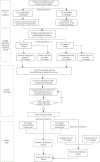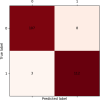A preliminary study on the application of deep learning methods based on convolutional network to the pathological diagnosis of PJI
- PMID: 36229852
- PMCID: PMC9563129
- DOI: 10.1186/s42836-022-00145-4
A preliminary study on the application of deep learning methods based on convolutional network to the pathological diagnosis of PJI
Abstract
Objective: This study aimed to establish a deep learning method based on convolutional networks for the preliminary study of the pathological diagnosis of prosthetic joint infections (PJI).
Methods: We enrolled 20 revision patients after joint replacement from the Department of Orthopedics, the First Medical Center, General Hospital of the People's Liberation Army, from January 2021 to January 2022 (10 of whom were confirmed to be infected against 2018 ICM criteria, and the remaining 10 were verified to be non-infected), and classified high-power field images according to 2018 ICM criteria. Then, we inputted 576 positive images and 576 negative images into a neural network by employing a resNET model, used to select 461 positive images and 461 negative images as training sets, 57 positive images and 31 negative images as internal verification sets, 115 positive images and 115 negative images as external test sets.
Results: The resNET model classification was used to analyze the pathological sections of PJI patients under high magnification fields. The results of internal validation set showed a positive accuracy of 96.49%, a negative accuracy of 87.09%, an average accuracy of 93.22%, an average recall rate 96.49%, and an F1 of 0.9482. The accuracy of external test results was 97.39% positive, 93.04% negative, the average accuracy of external test set was 93.33%, the average recall rate was 97.39%, with an F1 of 0.9482. The AUC area of the intelligent image-reading diagnosis system was 0.8136.
Conclusions: This study used the convolutional neural network deep learning to identify high-magnification images from pathological sections of soft tissues around joints, against the diagnostic criteria for acute infection, and a high precision and a high recall rate were accomplished. The results of this technique confirmed that better results could be achieved by comparing the new method with the standard strategies in terms of diagnostic accuracy. Continuous upgrading of extended training sets is needed to improve the diagnostic accuracy of the convolutional network deep learning before it is applied to clinical practice.
Keywords: Deep learning; Infected area; Neutrophil count; PJI (Prosthetic Joint Infections).
© 2022. The Author(s).
Conflict of interest statement
Guoqiang Zhang is the Editorial Board Member of
Figures
Similar articles
-
Application of high resolution computed tomography image assisted classification model of middle ear diseases based on 3D-convolutional neural network.Zhong Nan Da Xue Xue Bao Yi Xue Ban. 2022 Aug 28;47(8):1037-1048. doi: 10.11817/j.issn.1672-7347.2022.210704. Zhong Nan Da Xue Xue Bao Yi Xue Ban. 2022. PMID: 36097771 Free PMC article. Chinese, English.
-
Prediction of pulp exposure risk of carious pulpitis based on deep learning.Hua Xi Kou Qiang Yi Xue Za Zhi. 2023 Apr 1;41(2):218-224. doi: 10.7518/gjkq.2023.2022418. Hua Xi Kou Qiang Yi Xue Za Zhi. 2023. PMID: 37056189 Free PMC article. Chinese, English.
-
[Establishment and test results of an artificial intelligence burn depth recognition model based on convolutional neural network].Zhonghua Shao Shang Za Zhi. 2020 Nov 20;36(11):1070-1074. doi: 10.3760/cma.j.cn501120-20190926-00385. Zhonghua Shao Shang Za Zhi. 2020. PMID: 33238691 Chinese.
-
COVID-19 diagnosis: A comprehensive review of pre-trained deep learning models based on feature extraction algorithm.Results Eng. 2023 Jun;18:101020. doi: 10.1016/j.rineng.2023.101020. Epub 2023 Mar 16. Results Eng. 2023. PMID: 36945336 Free PMC article. Review.
-
Cancer Diagnosis Using Deep Learning: A Bibliographic Review.Cancers (Basel). 2019 Aug 23;11(9):1235. doi: 10.3390/cancers11091235. Cancers (Basel). 2019. PMID: 31450799 Free PMC article. Review.
Cited by
-
Digital orthopedics in the new AI era: from ASIA aspect.Arthroplasty. 2023 Dec 13;5(1):61. doi: 10.1186/s42836-023-00220-4. Arthroplasty. 2023. PMID: 38087379 Free PMC article.
-
Application of machine learning in the prevention of periprosthetic joint infection following total knee arthroplasty: a systematic review.Arthroplasty. 2023 Jun 14;5(1):38. doi: 10.1186/s42836-023-00195-2. Arthroplasty. 2023. PMID: 37316877 Free PMC article. Review.
-
Preoperative Diagnosis of Periprosthetic Infection in Patients Undergoing Hip or Knee Revision Arthroplasties: Development and Validation of Machine Learning Algorithm.Diagnostics (Basel). 2025 Feb 23;15(5):539. doi: 10.3390/diagnostics15050539. Diagnostics (Basel). 2025. PMID: 40075787 Free PMC article.
-
Effectiveness of Intra-Articular Injection of Ceftazidime/Vancomycin Combination during Total Knee Replacement: Prevention of Periprosthetic Joint Infection.Maedica (Bucur). 2023 Jun;18(2):197-202. doi: 10.26574/maedica.2023.18.2.197. Maedica (Bucur). 2023. PMID: 37588827 Free PMC article.
-
Clinically applicable optimized periprosthetic joint infection diagnosis via AI based pathology.NPJ Digit Med. 2024 Oct 26;7(1):303. doi: 10.1038/s41746-024-01301-7. NPJ Digit Med. 2024. PMID: 39462052 Free PMC article.
References
-
- Akgun D, Muller M, Perka C, Winkler T. The serum level of C-reactive protein alone cannot be used for the diagnosis of prosthetic joint infections, especially in those caused by organisms of low virulence. Bone Joint J. 2018;100 - B(11):1482–1486. doi: 10.1302/0301-620X.100B11.BJJ-2018-0514.R1. - DOI - PubMed
Grants and funding
LinkOut - more resources
Full Text Sources





